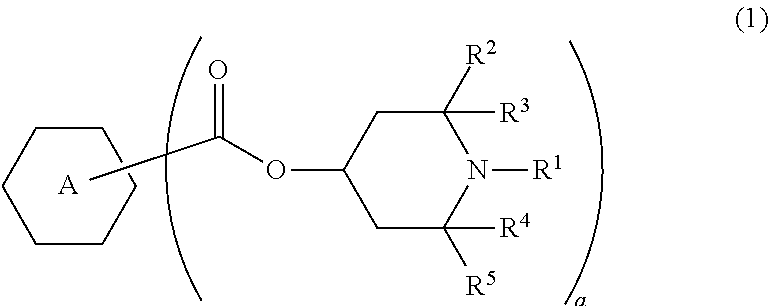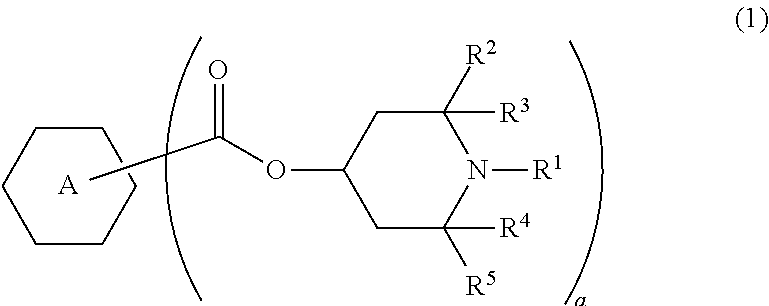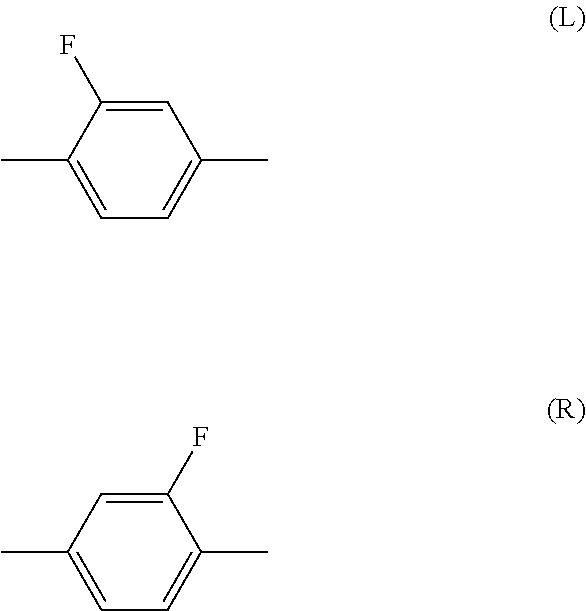Liquid crystal composition and liquid crystal display device
a liquid crystal display and composition technology, applied in the direction of liquid crystal compositions, chemical instruments and processes, etc., can solve the problems of large contrast ratio, small electric power consumption, long service life of the device, etc., and achieve high specific resistance, small viscosity, and high stability to ultraviolet light.
- Summary
- Abstract
- Description
- Claims
- Application Information
AI Technical Summary
Benefits of technology
Problems solved by technology
Method used
Image
Examples
example 1
[0139]
2-H1OB(2F,3F)-O2(2-4)3%3-H1OB(2F,3F)-O2(2-4)10%1V2-BB(2F,3F)-O2(2-5)10%V-HHB(2F,3F)-O1(2-7)12%V-HHB(2F,3F)-O2(2-7)12%3-HH1OB(2F,3F)-O2(2-10)6%2-BB(2F,3F)B-3(2-11)6%3-HH-V(3-1)25%3-HH-V1(3-1)6%4-HH-V1(3-1)3%V-HHB-1(3-5)3%V2-HHB-1(3-5)4%
[0140]The composition having a negative dielectric anisotropy was prepared, and characteristics thereof were measured. NI=80.1° C.; Tc<−20° C.; Δn=0.103; Δ∈=−3.9; Vth=2.09 V; η=20.7 mPa·s.
[0141]To the composition, compound (1-1) was added at a ratio of 0.1% by weight, and VHR-c of the resulting composition was measured. VHR-c=65.6%.
[0142]
example 2
[0144]
3-H1OB(2F,3F)-O2(2-4)8%V2-BB(2F,3F)-O1(2-5)4%V2-BB(2F,3F)-O2(2-5)9%1V2-BB(2F,3F)-O4(2-5)6%V-HHB(2F,3F)-O2(2-7)10%V-HHB(2F,3F)-O4(2-7)3%1V2-HHB(2F,3F)-O2(2-7)4%3-HH1OB(2F,3F)-O2(2-10)12%3-HH-V(3-1)26%1-HH-2V1(3-1)3%3-HH-2V1(3-1)3%5-HB-O2(3-2)3%3-HHB-O1(3-5)5%V-HHB-1(3-5)4%
[0145]The composition having a negative dielectric anisotropy was prepared, and characteristics thereof were measured. NI=77.0° C.; Tc<−20° C.; Δn=0.099; Δ∈=−3.4; Vth=2.22 V; η=18.6 mPa·s.
[0146]To the composition, compound (1-1) was added at a ratio of 0.07% by weight, and VHR-c of the resulting composition was measured. VHR-c=63.4%.
[0147]
example 3
[0148]
3-H2B(2F,3F)-O2(2-3)15%5-H2B(2F,3F)-O2(2-3)12%3-HHB(2F,3F)-O2(2-7)8%5-HHB(2F,3F)-O2(2-7)6%2-HHB(2F,3F)-1(2-7)5%3-HBB(2F,3F)-O2(2-15)10%4-HBB(2F,3F)-O2(2-15)6%1V2-HBB(2F,3F)-O2(2-15)4%2-HH-3(3-1)20%3-HH-4(3-1)10%V2-BB(F)B-1(3-8)4%
[0149]The composition having a negative dielectric anisotropy was prepared, and characteristics thereof were measured. NI=80.0° C.; Tc<−20° C.; Δn=0.096; Δ∈=−3.4; Vth=2.19 V; η=19.0 mPa·s.
[0150]To the composition, compound (1-2) was added at a ratio of 0.1% by weight, and VHR-c of the resulting composition was measured. VHR-c=87.1%.
[0151]
PUM
| Property | Measurement | Unit |
|---|---|---|
| temperature | aaaaa | aaaaa |
| temperature | aaaaa | aaaaa |
| response time | aaaaa | aaaaa |
Abstract
Description
Claims
Application Information
 Login to View More
Login to View More - R&D
- Intellectual Property
- Life Sciences
- Materials
- Tech Scout
- Unparalleled Data Quality
- Higher Quality Content
- 60% Fewer Hallucinations
Browse by: Latest US Patents, China's latest patents, Technical Efficacy Thesaurus, Application Domain, Technology Topic, Popular Technical Reports.
© 2025 PatSnap. All rights reserved.Legal|Privacy policy|Modern Slavery Act Transparency Statement|Sitemap|About US| Contact US: help@patsnap.com



